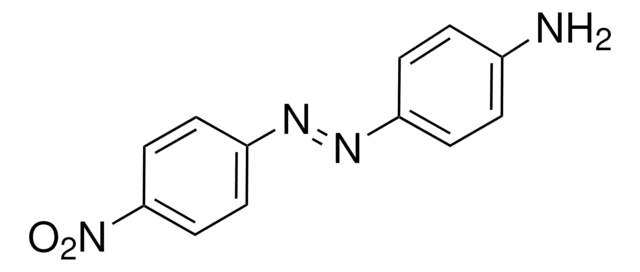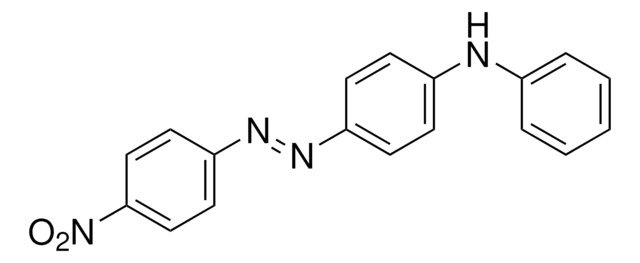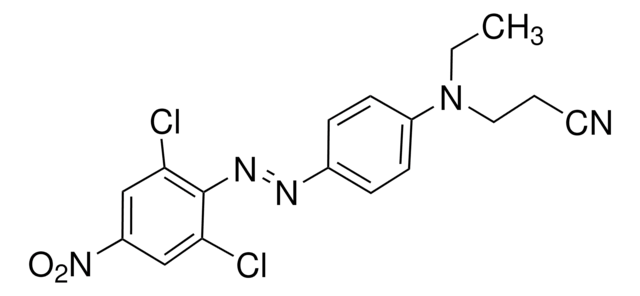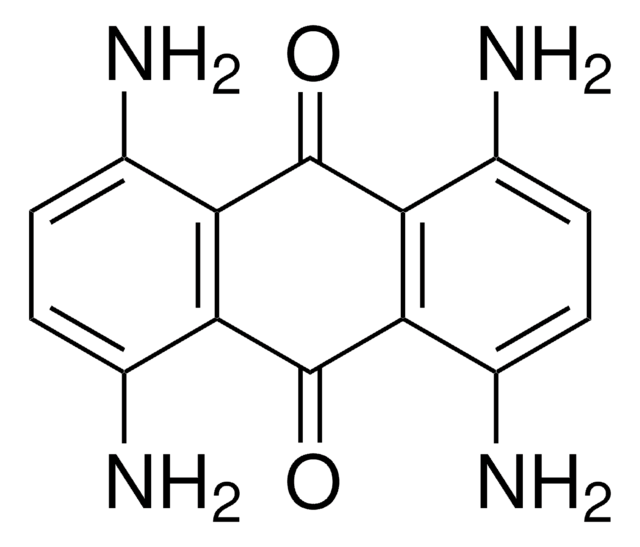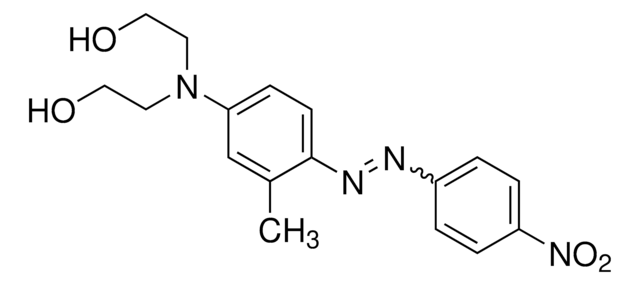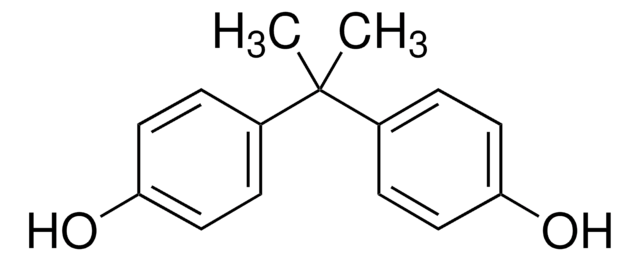모든 사진(2)
About This Item
Linear Formula:
O2NC6H4N=NC6H4NH2
CAS Number:
Molecular Weight:
242.23
색상 지수 번호:
11005
Beilstein:
1842907
EC Number:
MDL number:
UNSPSC 코드:
85151701
PubChem Substance ID:
NACRES:
NA.24
추천 제품
Grade
analytical standard
Quality Level
분석
≥96.0% (HPLC)
기술
HPLC: suitable
gas chromatography (GC): suitable
mp
~200 °C (dec.) (lit.)
λmax
443 nm
응용 분야
cleaning products
cosmetics
environmental
food and beverages
personal care
형식
neat
SMILES string
Nc1ccc(cc1)\N=N\c2ccc(cc2)[N+]([O-])=O
InChI
1S/C12H10N4O2/c13-9-1-3-10(4-2-9)14-15-11-5-7-12(8-6-11)16(17)18/h1-8H,13H2/b15-14+
InChI key
UNBOSJFEZZJZLR-CCEZHUSRSA-N
유사한 제품을 찾으십니까? 방문 제품 비교 안내
일반 설명
Disperse Orange 3 is widely used in textile industry for dyeing polyester fibers.
애플리케이션
Disperse Orange 3 may be used as a test material for investigating its degradation by the white rot fungus Pleurotus ostreatus and the products obtained upon degradation are determined using UV-visible spectrophotometric and high-performance liquid chromatographic techniques.
Refer to the product′s Certificate of Analysis for more information on a suitable instrument technique. Contact Technical Service for further support.
특징 및 장점
Used to provide experimental verification of a two-level model for the enhancement of the nonresonant, nonlinear refractive index, with a decrease in absorption by reduction of a donor group strength.
신호어
Warning
유해 및 위험 성명서
Hazard Classifications
Eye Irrit. 2 - Skin Irrit. 2 - Skin Sens. 1 - STOT SE 3
표적 기관
Respiratory system
Storage Class Code
11 - Combustible Solids
WGK
WGK 3
Flash Point (°F)
Not applicable
Flash Point (°C)
Not applicable
개인 보호 장비
dust mask type N95 (US), Eyeshields, Faceshields, Gloves
가장 최신 버전 중 하나를 선택하세요:
A A Ahmad et al.
Journal of hazardous materials, 170(2-3), 612-619 (2009-06-12)
The purpose of this work is to obtain optimal preparation conditions for activated carbons prepared from rattan sawdust (RSAC) for removal of disperse dye from aqueous solution. The RSAC was prepared by chemical activation with phosphoric acid using response surface
HPLC and spectrophotometric analysis of biodegradation of azo dyes by Pleurotus ostreatus
Zhao X and Hardin RI
Dyes and Pigments, 73(3), 322-325 (2007)
Anthony T-J Goon et al.
Contact dermatitis, 48(5), 248-250 (2003-07-19)
Cross-sensitization between para-phenylenediamine (PPD) and Disperse Orange 3 (DO3), among other textile dyes, has frequently been reported. We evaluated the frequency of simultaneous patch test reactions to PPD and a range of textile dyes. Retrospectively, we studied 128 patients who
Laura Malinauskiene et al.
Contact dermatitis, 68(2), 65-75 (2013-01-08)
Several disperse dyes (DDs) are still considered to be the most important allergens in textile dermatitis, but there are sparse data about their current use in textiles. The aim of this review was to evaluate published studies and reports on
Manfred Kneilling et al.
Experimental dermatology, 19(5), 435-441 (2010-02-02)
Patients sensitized to para-phenylenediamine (PPD) by semi-permanent tattoos increasingly develop threatening allergic reactions in response to black hair dye. The gold standard to diagnose allergic contact dermatitis is to perform epicutaneous patch tests, however, iatrogenic sensitizations and severe patch test
자사의 과학자팀은 생명 과학, 재료 과학, 화학 합성, 크로마토그래피, 분석 및 기타 많은 영역을 포함한 모든 과학 분야에 경험이 있습니다..
고객지원팀으로 연락바랍니다.